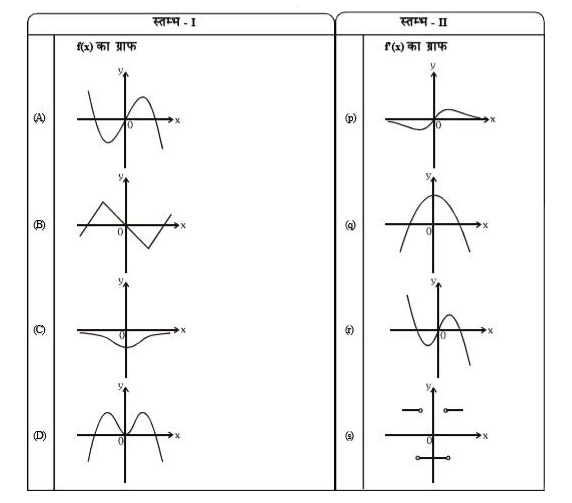किसी बिंदु. x = a पर एक फलन f(x) का बायाँ और दायां अवकलज क्रमशः f(a−)=limh→0+(f(a)−h)h=limh→0+f(a+h)−f(a)h और f(a+)=limh→0+f(a+h)−f(a)h=limh→0−f(a)−f(a−h)h=limx→a+f(a)−f(x)a−x द्वारा परिभषित किया जाता है।
माना की f दो बार अवकलनीय फलन है। हम जानते है की सैम फलन का अवकलज विषम फलन तथा विषम फलन का सैम फलन होता है।
उपरोक्त जानकारी के आधार पर , निम्न प्रश्नों के उत्तर दीजिए :
यदि f सम है , तो निम्न में से कौन-सा x = a पर f' का दायां अवकलज है -
limh→0−f'(a)+f'(−a+h)h
limh→0+f'(−a)+f'(−a−h)h
limh→0+−f'(−a)+f'(−a−h)−h
limh→0+f'(a)+f'(−a+h)−h
The correct Answer is:A
Step by step video, text & image solution for किसी बिंदु. x = a पर एक फलन f(x) का बायाँ और दायां अवकलज क्रमशः f(a^(-))=lim_(hrarr0^(+))((f(a)-h))/h=lim_(h rarr0^(+))(f(a+h)-f(a))/h और f(a^(+))=lim_(hrarr0^(+))(f(a+h)-f(a))/h=lim_(h rarr0^(-))(f(a)-f(a-h))/h=lim_(x rarra^(+))(f(a)-f(x))/(a-x) द्वारा परिभषित किया जाता है। माना की f दो बार अवकलनीय फलन है। हम जानते है की सैम फलन का अवकलज विषम फलन तथा विषम फलन का सैम फलन होता है। उपरोक्त जानकारी के आधार पर , निम्न प्रश्नों के उत्तर दीजिए : यदि f सम है , तो निम्न में से कौन-सा x = a पर f' का दायां अवकलज है - by Maths experts to help you in doubts & scoring excellent marks in Class 12 exams.
Updated on:21/07/2023Topper's Solved these Questions
- METHODS OF DIFFERENTIATIONBOOK - ALLEN HINDICHAPTER - METHODS OF DIFFERENTIATIONEXERCISE - EXERCISE - 04 [A]
24 Videos
- METHODS OF DIFFERENTIATIONBOOK - ALLEN HINDICHAPTER - METHODS OF DIFFERENTIATIONEXERCISE - EXERCISE - 04 [B]
11 Videos
- METHODS OF DIFFERENTIATIONBOOK - ALLEN HINDICHAPTER - METHODS OF DIFFERENTIATIONEXERCISE - EXERCISE - 03 (MISCELLANEOUS TYPE QUESTIONS ) (स्तम्भ सुमेलन)
2 Videos
- MAXIMA-MINIMABOOK - ALLEN HINDICHAPTER - MAXIMA-MINIMAEXERCISE - EXERCISE-05 [B] JEE-[ADVANCED] (PREVIOUS YEAR QUESTIONS)
22 Videos
- MONOTONOCITYBOOK - ALLEN HINDICHAPTER - MONOTONOCITYEXERCISE - EXERCISE - 05 [B] ( JEE-[ADVANCED] : PREVIOUS YEAR QUESTIONS )
28 Videos
Similar Questions
यदि y=a+bx3/2x5/4 हो तथा dydx=0,x=5 पर विलुप्त होता हो, तब ab से ज्ञात कीजिए।
View Solutionयदि x=1z तथा y= f(x), तो प्रदर्शित कीजिए कि d2fdx2=2z3dydz+z4d2ydz2
View Solution
View Solutionमाना f(x)={x0<x≤2 के लिए1x=0 के लिए ' है, तो x = 0 पर फलन का
View Solution(a) सभी x∈(0,1) के लिए सत्य है -
View SolutionIf f(x)=(1)/(x), evaluate lim_(h rarr0)(f(x+h)-f(x))/(h)
View SolutionLet f be differentiable at x=0 and f'(0)=1 Then lim_(h rarr0)(f(h)-f(-2h))/(h)=
View SolutionSuppose f(x) is differentiable at x=1 and lim_(h rarr0)(1)/(h)f(1+h)=5, then f'(1) equal
View SolutionIf f(x) is a differentiable function of x then limh→0f(x+3h)−f(x−2h)h=
View Solutionif quad f(x)=ax^(2)+bx+c, showthat lim_(h rarr0)(f(x+h)-f(x))/(h)=2ax+b
View Solutionअवकलनीय फलन f, के लिए limh→0[f(x+h)]2−[f(x)]22h का मान-
View SolutionLeft hand derivative and right hand derivative of a function f(x) at a point x=a are defined as
f'(a−)=–––lim(h→0+)f(a)−f(a−h)h
=limh→0+f(a+h)−f(a)h
andf'(a+)=limh→0+f(a+h)−f(a)h
=limh→0+f(a)−f(a+h)h
=limh→0+f(a)−f(x)a−x respectively.
Let f be a twice differentiable function. We also know that derivative of a even function is odd function and derivative of an odd function is even function.
If f is even function, which of the following is right hand derivative of f' at x=a?
View Solutionlimh→0f(a+h)−f(a)h=
View Solutionlim_(h rarr 0) (f(a+h)-f(a))/(h) is
View Solutionlim_(h rarr 0) (f(a-h)-f(a))/(-h) is
View Solution

